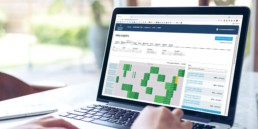Smart waste management utilizes data
In this series of articles, we present the experts behind the Europress SMART system and share their thoughts regarding how smart waste management is changing the operating environment of the circular economy.
In the third article in this series, Senior SMART Specialist Ben Mårtens describes what data is obtained from the SMART system and how it is used. Everyone in the waste management chain benefits from data: the users of the devices at waste collection points, waste carriers, companies receiving the waste, property managers, those responsible for waste management procurements, and technicians who service and maintain waste management equipment.
Data is generated when the smart center in the waste compactor or waste baler collects information during operation. The data collected is stored in the SMART Server cloud service. Devices transmit data whenever the device registers an event connected to its use, such as an increase in the fill level, an emptying or a blockage or other fault.
“Using realtime data, we can react fast and even fix the problem before the customer will notice it,” says Mårtens.

Using realtime data, we can react fast and even fix the problem before the customer will notice it.
The data can be used to optimize operations at the waste collection point and together with waste carriers to ensure that the devices are emptied as infrequently as possible while always being ready to use. Devices can even forecast when they will be full.
“The transport manager at the waste carrier checks the forecast a few times a week and takes it into account when optimizing emptying times, for example around weekends and public holidays,” Mårtens explains.
Europress is continuously developing SMART services in response to the needs of customers by inviting feedback and asking about their specific wishes. This ensures that development activities are focused on exactly the right areas. In addition to general usability, for example, individual features can be improved or added. Mårtens provides an illustrative example of this:
“One of our customers removes waste bales two at a time. The customer asked whether information about when the waste bales are ready could be sent automatically to the waste carrier. We solved this by adding a bale counter feature to the waste balers.”
Customer can follow the progress of service event at SMARTwaste app in real time.
The focus of development work is to make service as automatic as possible. The data systems that Europress service uses, are integrated into each other that enables transparency of service to customer.
“Customer can follow the progress of service event at SMARTwaste app in real time,” says Mårtens.




